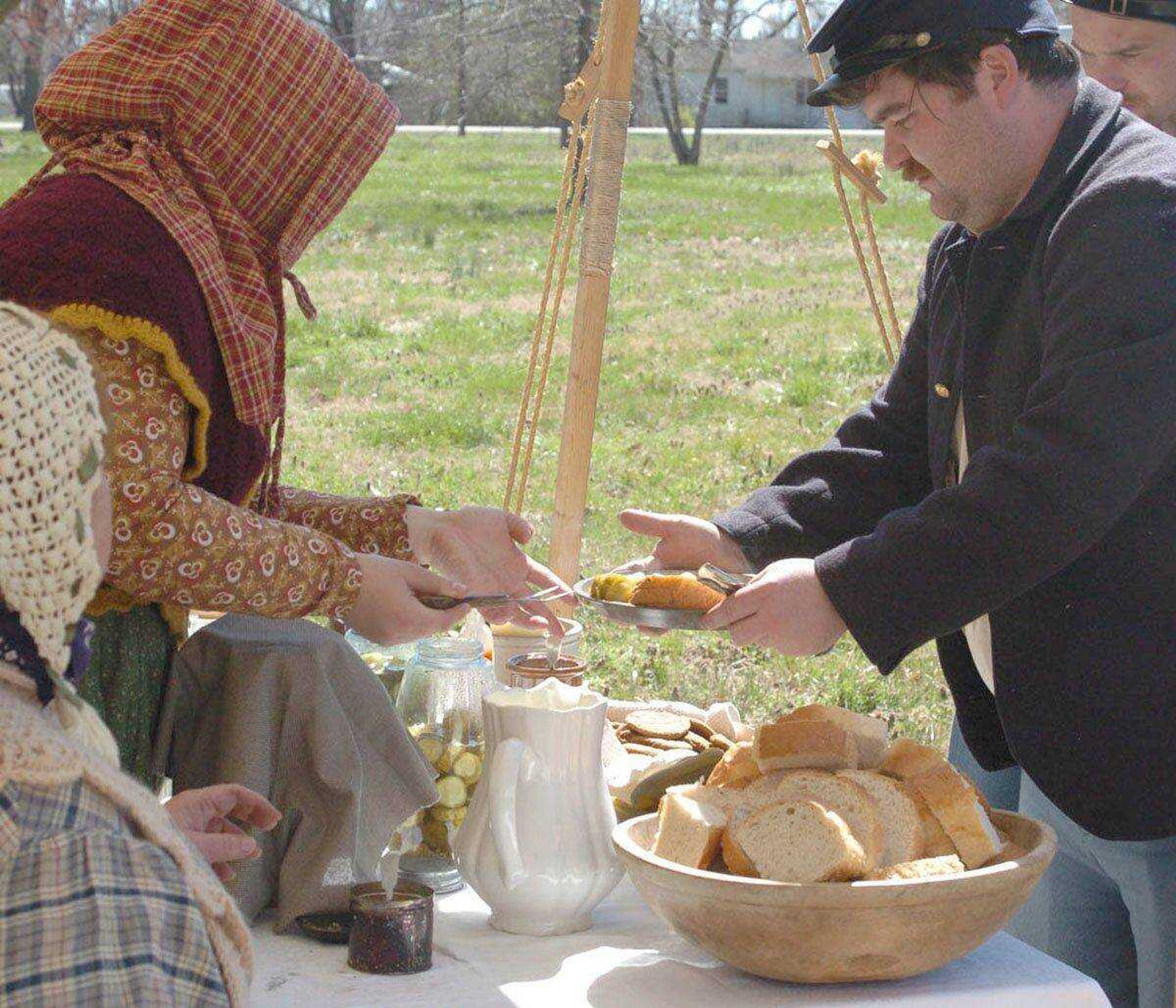NEW MADRID, Mo. -- Steve LaBarre has been a Union officer and fought for the Confederacy. He has been a Civil War sutler and a civilian. But the job that had him sweating at the re-enactment of the siege of New Madrid was cook.
The Manteno, Ill., native along with his wife, Becky, and mother, Michelle, were in charge of the meals for the 35 soldiers camped in tents next to the Hunter-Dawson State Historic Site last weekend. They were serving food that would not only keep the re-enactors full but would also reflect those meals served to soldiers in 1861, when family legend has it that Gen. John Polk and his soldiers turned the antebellum home into military headquarters.
LaBarre and his wife met while re-enacting. The couple re-create characters from throughout the 19th century, but LaBarre said the Civil War is their primary period, taking part in events at national parks, museums and, like last weekend, at state historic sites.
While the weekend's military encampment was small, the couple said their work as camp cooks required a lot of research to ensure it would be accurate, both historically and seasonally. They said they began their research about two months ago, looking for recipes and planning their menus.
"The cooking is fun," Becky LaBarre said. "Getting them fed on time is a little of a challenge."
To do so, the trio started their day at 5 a.m., building their fire and preparing breakfast. Once breakfast was served, they cleaned up the dishes, then began work for the noon meal. Then it was time to clean up and start on the evening meal.
Becky LaBarre said because they were recreating a March encampment, there would have been no fresh fruits available. Their kitchen included dried fruits and jars of fruit preserves.
Their eye for accuracy covers the smallest details.
Becky LaBarre said as they looked for the right type of pickles to serve, they avoided those pickles with the crinkle cut, which would not have been invented yet. They opted instead for the straight sliced pickles or whole pickles.
Root vegetables would have been plentiful and the camp kitchen had baskets of potatoes, turnips, parsnips and carrots to add to the meals. Becky LaBarre said when they went shopping they only chose the smallest of each, which would have been typical of the size grown in the 1860s.
Crouched over the open camp fire, LaBarre skillfully turned the beef steaks then plated them. He used the drippings in the pan to stir up a gravy.
"We do have fresh meat," Becky LaBarre said. "In this area the weather is mild, they would still do butchering into the spring."
The officers had beef steaks while the enlisted men filled up on beef stew. Sausages were also included in their meal planning.
According to Becky LaBarre, when someone such as Polk would commandeer a home, he would also help himself to the homeowner's food and possessions. At the weekend encampment, the officers' meals were served on English bone china and they drank from glassware.
She noted even the china they were using in the field was a pattern dating back to the 1850s, making it as an authentic addition to the camp as the enlisted men's tin plates and cups.
Becky LaBarre pointed out there were benefits of being in a community in the 1860s. The cooks would be able to acquire some things from the sutlers or traveling merchants who often came to the camps. One of those things a cook might buy to add to their menu, she said, was lemon sugar, which was made by from dried lemons, which are pulverized and mixed with sugar.
"It's like our lemonade mix of today," she said.
Michelle LaBarre took a turn stirring the stew, sampling it then adding salt from a jar. She said they scoured cookbooks for recipes from the 1860s which would work for the encampment. The beef steak, she said, was from a cookbook of the time period.
Finding the ingredients of the time period was even more of a challenge.
"Back then you couldn't go to the supermarket nothing was in season fruit-wise, so you had to use dried fruits. Well-to-do families had provisions so we would have had those at our disposal," she said about accurately recreating the meals.
While it is a lot of work, Michelle LaBarre said they were enjoying recreating the life of camp cooks.
"I love it when we can show people the history of their ancestors. We are giving them a sense of what it would be like," she said. "You can read it in a book but when you come out here, you feel it, you taste it, you live it."
jillb@standard-democrat.com
Connect with the Southeast Missourian Newsroom:
For corrections to this story or other insights for the editor, click here. To submit a letter to the editor, click here. To learn about the Southeast Missourian’s AI Policy, click here.








